This question is based on Python - Pandas - Combining rows of multiple columns into single row in dataframe based on categorical value which I had asked earlier.
I have a table in the following format:
Var1 Var2 Var3 Var4 ID
0 0.70089 0.93120 1.867650 0.658020 1
1 0.15893 -0.74950 1.089150 -0.045123 1
2 0.13690 0.59210 -0.032990 0.672860 1
3 -0.50136 0.89913 0.440200 0.812150 1
4 1.08940 0.43036 0.669470 1.286000 1
5 0.09310 0.14979 -0.392335 0.040500 1
6 7 0.63339 1.27161 0.852072 0.474800 2
7 8 -0.54944 -0.04547 0.867050 -0.234800 2
8 9 1.28600 1.87650 0.976670 0.440200 2
I have created the above table using the using the following code:
import pandas as pd
df1 = {'Var1': [0.70089, 0.15893, 0.1369, -0.50136, 1.0894, 0.0931, 0.63339, -0.54944, 1.286], Var2': [0.9312, -0.7495, 0.5921, 0.89913, 0.43036, 0.14979, 1.27161, -0.04547, 1.8765], 'Var3': [1.86765, 1.08915,-0.03299, 0.4402, 0.66947, -0.392335, 0.852072, 0.86705, 0.97667], 'Var4': [0.65802, -0.045123, 0.67286, 0.81215, 1.286, 0.0405, 0.4748, -0.2348, 0.4402] 'ID':[1, 1, 1, 1, 1, 1, 2, 2, 2]}
df=pd.Dataframe(data=df1)
I want to bring it into a particular format by grouping it based on the column 'ID'.
The desired output is similar in structure to the table below:
ID V1_0_0 V2_0_1 V3_0_2 V4_0_3 V1_1_0 V2_1_1 V3_1_2 V4_1_3
1 A B C D E F G H
2 I J K L 0 0 0 0
I achieved it with the help of user Allen in the last question that is referenced above. The code is printed below:
num_V = 4
max_row = df.groupby('ID').ID.count().max()
df= df.groupby('ID').apply(lambda x: x.values[:,1:].reshape(1,-1)
[0].apply(lambda x: x.values[:,1:].reshape(1,-1)[0]).apply(pd.Series)
.fillna(0)
df.columns = ['V{}_{}_{}'.format(i+1,j,i) for j in range(max_row) for i in
range(num_V)]
print(df)
The result of which produces the below output table:
V1_0_0 V2_0_1 V3_0_2 ***V4_0_3** V1_1_0 V2_1_1 V3_1_2 \
ID
1 0.93120 1.867650 0.65802 1 -0.74950 1.08915 -0.045123
2 1.27161 0.852072 0.47480 2 -0.04547 0.86705 -0.234800
**V4_1_3*** V1_2_0 V2_2_1 ...V3_3_2 **V4_3_3** V1_4_0 V2_4_1 \
ID ...
1 1 0.5921 -0.03299 ... 0.81215 1 0.43036 0.66947
2 2 1.8765 0.97667 ... 0.00000 0 0.00000 0.00000
V3_4_2 **V4_4_3** V1_5_0 V2_5_1 V3_5_2 **V4_5_3**
ID
1 1.286 1 0.14979 -0.392335 0.0405 1
2 0.000 0 0.00000 0.000000 0.0000 0
This is partially correct, but the problem is that there are certain columns that give the value of 1 and 2 after every 3 columns (the ones between ** **). It then prints 1 and 0 after there are no values pertaining to the 'ID' value 2. After examining it I realize that it is not printing the "Var1" values, and the values are off by one column. (That is V1_0_0 should be 0.70089, and the real value of V4_0_3should have the value of V3_0_2 which equals 0.65802.
Is there any way to rectify this so that I get something exactly like my desired output table? How do I make sure the ** ** marked columns delete the values they have and return the proper values?
I am using Python 3.4 running it on a Linux Terminal
Thanks.
